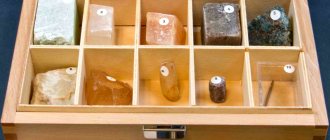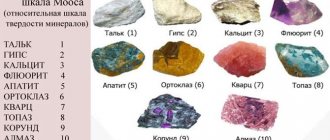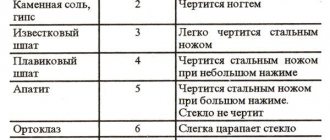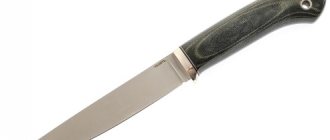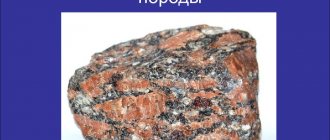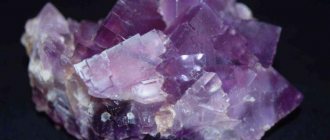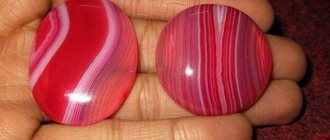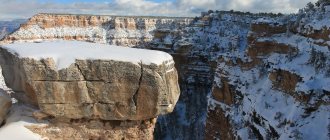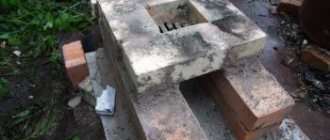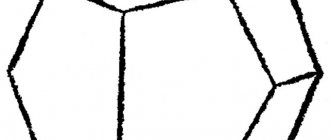The mineral hardness scale or Mohs mineralogical scale is compiled from reference samples according to the degree of relative hardness from 1 to 10. A qualitative ordinal indicator of the strength resistance of minerals included in this scale is determined by scratching. The mechanical ability of harder materials to scratch softer rocks determines the relative hardness of a particular type of mineral.
The 10 Mohs mineral elements are presented as reference samples and arranged in ascending order, allowing you to visually determine which mineral is harder. For example, talc occupies the first position in the table and is considered the softest among others presented on the scale. On the other side is a diamond, which, according to the “mineral strength” criterion, occupies the very top, that is, the 10th position on the Mohs scale and has no analogues in nature in terms of this indicator.
Determination of mineral hardness
Hardness is determined as follows. A smooth area is selected on the surface of the mineral under study and, taking a mineral from the Mohs scale, it is passed along it at an acute angle with pressure. If a scratch remains on the surface of the sample under study, then its hardness is less than that of the reference mineral. It is necessary to make sure that it is the scratch (indentation) that remains on the test sample, and not the powder of the reference sample.
Using sequential reference minerals from the softest to the hardest, a position is achieved where the test sample is located in its hardness between two reference minerals or the test sample is scratched by the reference one and itself scratches it. In the first case, the hardness of the test sample is estimated to be an average value, in the second case it is equal to the hardness of the reference one. For example, if a mineral is scratched by quartz and not scratched by orthoclase, then its hardness is 6.5. If another mineral is scratched by calcite and itself leaves a scratch on it, then its hardness is 3.
(In the absence of the Mohs scale, the hardness of minerals can be determined in other ways.
Thus, the graphite of a soft pencil has a hardness of about 1. Minerals with such hardness write on paper without leaving scratches on it.
Minerals with a hardness of up to 2 can be scratched with a fingernail; an iron nail and wire have a hardness of 4 (bronze coin 3.5-4), glass - 5, a steel knife, a needle - 6. Quartz, which has a hardness of 7, is widely found in nature)..
It should be kept in mind that individual minerals may have different hardness in different directions. For example, the hardness of disthene along an elongated edge is 4, and perpendicular to it - 6.
To determine the hardness of a mineral, which is a powdery or earthy aggregate, it is necessary to rub the powder on a reference sample.
If the latter is covered with scratches, then the hardness of the standard is less than that of the test sample.
It is important to emphasize that Mohs hardness units are relative. So, for example, a diamond using the indentation method has a hardness of 10,000 kg/mm2, and talc - 43 kg/mm2, i.e. the hardness of diamond is not 10, but 232 times greater than the hardness of talc.
APPLICATION
Blue transparent sapphires are used in jewelry in the form of cuts. Star sapphires are usually cut as cabochons. Synthetic leucosapphires are used as raw materials for the manufacture of ophthalmic scalpels and eye lenses; for the production of high-strength optically transparent elements (windows for space stations, protective glass for optical equipment in rockets and aircraft, protective glass for screens in mobile phones, watches and cameras in the highest price segment); as substrates in microcircuits; in dentistry - for the production of aesthetic braces, in industry - for the production of nozzles for water jet machines. Unlike quartz, leucosapphire does not react with alkali metal vapors up to the highest temperatures, which is why high-pressure sodium lamp burners are mass-produced from artificial leucosapphire. Leucosapphires are also used in various fields of laser technology. Synthetic sapphire, activated with Ti3+ ions, is used as active elements in titanium-sapphire lasers.
Sapphire – Al2O3
| Molecular weight | 101.96 g/mol |
| origin of name | The origin of the name of the stone has not yet been precisely established |
| IMA status | valid |
Mohs scale. Mineral hardness
The Mohs scale (mineralogical hardness scale) is a set of reference minerals for determining relative hardness using the scratching method.
10 minerals, arranged in order of increasing hardness, were taken as standards.
Consists of 10 hardness standards: talc - 1; gypsum - 2; calcite - 3; fluorite - 4; apatite - 5; orthoclase - 6; quartz - 7; topaz - 8; corundum - 9; diamond - 10.
Minerals
with an index below 7 are considered
soft
, above 7 -
hard
.
In general, the bulk of natural compounds have a hardness of 2 to 6.
The hardness scale was proposed in 1811 by the German mineralogist Friedrich Mohs.
- this is the resistance that its surface provides when trying to scratch it with another stone or other object
; hardness is a measure of the coherence of the atomic structure of a substance.
The hardness of the same stone can be different in different directions
. It stands out among other minerals by its large difference in hardness in different directions: its hardness varies from 5 to 7, and in some directions the sample can be scratched with a knife, but in others not.
The 1 to 10 scale represents 10 common minerals, from talc to diamond.
.
A mineral's hardness is measured by finding the hardest reference mineral it can scratch; and/or the softest reference mineral that scratches the given mineral. Everything is very simple. For example, if a mineral is scratched by apatite but not by fluorite, then its hardness is in the range of 4 to 5.
Intermediate degrees of stone hardness are expressed as fractions. Thus, the number 8 1/2, referring to chrysoberyl, means that it scratches topaz in much the same way as it scratches itself with corundum.
Pyrope garnet is slightly harder than quartz (7) and slightly softer than beryl (7 1/2), so its hardness is designated as 7 1/4.
It is important to remember that cryptocrystalline, finely porous and powdery varieties of minerals have false low hardnesses
.
For example, hematite in crystals has a hardness of 6, but in the form of red ocher it is less than 4.
Every owner of a diamond ring knows that a diamond easily scratches window glass.
Diamonds are used to cut glass. If we try other precious stones, we will find that they also scratch glass, but not so easily, and then topaz scratches window glass, but the topaz itself is scratched by corundum, which in turn gives in to the all-powerful and hardest diamond.
Samples of the same minerals obtained from different places differ from each other in the complexity of the cutting and polishing process.
It is said of diamonds from Kalimantan and New South Wales that they are considerably harder than those from South Africa and other places and that they are difficult to cut.
Ceylon sapphires are harder than rubies, while Kashmir sapphires are softer.
The Mohs scale is intended for a rough comparative assessment of the hardness of materials according to the softer-harder system. The material being tested either scratches the standard and its hardness on the Mohs scale is higher, or it scratches the standard and its hardness is lower than the standard.
Thus, the Mohs scale only informs about the relative hardness of minerals
.
In addition to the Mohs scale, of course, there are other methods for determining the hardness of minerals, but the different hardness scales cannot be unambiguously correlated with each other
.
Several more accurate systems for measuring the hardness of materials have been adopted in practice, none of which covers the entire spectrum of the Mohs scale.
Can a diamond be scratched or broken with a hammer?
Based on the above, we can conclude: it is impossible to scratch a diamond. This makes it possible to quickly identify rough glass counterfeits that are easily scratched by a steel needle or nail file. True, imitation diamonds like cubic zirconia, and even more so carborundum, cannot be recognized in this way.
But there are plenty of substances stronger than diamond - and even steel! This means breaking a diamond is quite possible. Naturally, the stone will calmly survive a fall from a considerable height, and even if you step on it, nothing critical will happen. But if you hit the diamond with force with a hammer, it will crack, otherwise it will crumble into small crumbs.
But you shouldn’t do this: the experiment will be too expensive, and the world will lose another diamond that has been formed over hundreds of millions of years!
19.04.21
Household hardness measuring instruments
Sometimes to determine hardness you have to use the tools that are at hand
, although in some cases
they are not accurate enough
(pencil -1, table salt - 2, fingernail - 2.5, copper coin - 3, iron nail - 4, glass - 5, steel knife - 6, file - 7).
When determining hardness, a fresh mineral surface should always be tested.
good to remember:
- the nail leaves a scratch on plaster and softer substances
- regular window glass is slightly softer than feldspar
- The steel blade of the knife is slightly harder than feldspar, approaching quartz in hardness, and scratches glass easily.
Classification of natural stone materials by hardness
| Solid | Medium hard | Soft |
| Granite, gneiss, diorite, syenite, gabbro, labradorite, teschenite, diabase, quartz porphyry, basalt | Marble (achromatic and chromatic), conglomerate, breccia, limestone, sandstone, volcanic tuff, calcareous tuff, shale | Gypsum, talc |
Table of relationships between hardness numbers according to Brinell, Rockwell, Vickers, Shore
Rockwell, Vickers and Shore hardness values indicated correspond to Brinell hardness values determined using a 10 mm diameter ball.
| According to Rockwell | According to Brinell | Vickers (HV) | By Shore | |||
| H.R.C. | HRA | HRB | Imprint diameter | HB | ||
| 65 | 84,5 | – | 2,34 | 688 | 940 | 96 |
| 64 | 83,5 | – | 2,37 | 670 | 912 | 94 |
| 63 | 83 | – | 2,39 | 659 | 867 | 93 |
| 62 | 82,5 | – | 2,42 | 643 | 846 | 92 |
| 61 | 82 | – | 2,45 | 627 | 818 | 91 |
| 60 | 81,5 | – | 2,47 | 616 | – | – |
| 59 | 81 | – | 2,5 | 601 | 756 | 86 |
| 58 | 80,5 | – | 2,54 | 582 | 704 | 83 |
| 57 | 80 | – | 2,56 | 573 | 693 | – |
| 56 | 79 | – | 2,6 | 555 | 653 | 79,5 |
| 55 | 79 | – | 2,61 | 551 | 644 | – |
| 54 | 78,5 | – | 2,65 | 534 | 618 | 76,5 |
| 53 | 78 | – | 2,68 | 522 | 594 | – |
| 52 | 77,5 | – | 2,71 | 510 | 578 | – |
| 51 | 76 | – | 2,75 | 495 | 56 | 71 |
| 50 | 76 | – | 2,76 | 492 | 549 | – |
| 49 | 76 | – | 2,81 | 474 | 528 | – |
| 48 | 75 | – | 2,85 | 461 | 509 | 65,5 |
| 47 | 74 | – | 2,9 | 444 | 484 | 63,5 |
| 46 | 73,5 | – | 2,93 | 435 | 469 | – |
| 45 | 73 | – | 2,95 | 429 | 461 | 61,5 |
| 44 | 73 | – | 3 | 415 | 442 | 59,5 |
| 42 | 72 | – | 3,06 | 398 | 419 | – |
| 40 | 71 | – | 3,14 | 378 | 395 | 54 |
| 38 | 69 | – | 3,24 | 354 | 366 | 50 |
| 36 | 68 | – | 3,34 | 333 | 342 | – |
| 34 | 67 | – | 3,44 | 313 | 319 | 44 |
| 32 | 67 | – | 3,52 | 298 | 302 | – |
| 30 | 66 | – | 3,6 | 285 | 288 | 40,5 |
| 28 | 65 | – | 3,7 | 269 | 271 | 38,5 |
| 26 | 64 | – | 3,8 | 255 | 256 | 36,5 |
| 24 | 63 | 100 | 3,9 | 241 | 242 | 34,5 |
| 22 | 62 | 98 | 4 | 229 | 229 | 32,5 |
| 20 | 61 | 97 | 4,1 | 217 | 217 | 31 |
| 18 | 60 | 95 | 4,2 | 207 | 206 | 29,5 |
| – | 59 | 93 | 4,26 | 200 | 199 | – |
| – | 58 | – | 4,34 | 193 | 192 | 27,5 |
| – | 57 | 91 | 4,4 | 187 | 186 | 27 |
| – | 56 | 89 | 4,48 | 180 | 179 | 25 |
Threaded holes
Table of drills for holes for cutting cylindrical pipe threads.
Wrench nut sizes
Basic spanner dimensions for hex bolt heads and hex nuts.
Read also: Pke 722 2у2 connection diagram
G and M codes
Examples, description and interpretation of L and M codes for creating control programs on CNC milling and lathes.
Thread types
Types and characteristics of metric, pipe, thrust, trapezoidal and round threads.
Drawing scales
Standard scales for images of parts on mechanical engineering and construction drawings.
Cutting modes
Online calculator for calculating cutting conditions during turning.
Threaded holes
Table of drills and holes for cutting metric threads with large (main) pitch.
CNC machines
Classification of CNC machines, CNC machines for metal for turning, milling, drilling, boring, threading, reaming, countersinking.
Cutting modes
Online calculator for calculating cutting conditions when milling.
Drawing formats
Table of side sizes of main and additional formats of drawing sheets.
CAD/CAM/CAE systems
CAD computer-aided design systems, 3D programs for design, modeling and creation of 3D models.
Linear hardness
Linear hardness is determined by the absolute hardness scale, not the Mohs scale.
Here is the absolute hardness scale:
Talc - 1 - Can be scratched by a fingernail Gypsum - 3 - Scratched by a fingernail Calcite - 9 - Scratched by a copper coin Fluorite - 21 - Easily scratched by a knife Apatite - 48 - Hardly scratched by a knife Orthoclase - 72 - Scratched by a file Quartz - 100 - Scratched window glass Topaz - 200 — Easily scratches quartz Corundum — 400 — Easily scratches topaz Diamond — 1600 — Not scratched by anything (and at the same time easily scratches corundum)
HardnessMineralAbsolute hardness
| 1 | Talc (Mg3Si4O10(OH)2) | 1 |
| 2 | Gypsum (CaSO4 2H2O) | 3 |
| 3 | Calcite (CaCO3) | 9 |
| 4 | Fluorite (CaF2) | 21 |
| 5 | Apatite (Ca5(PO4)3(OH-,Cl-,F-)) | 48 |
| 6 | Feldspars (KAlSi3O8) | 72 |
| 7 | Quartz (SiO2) | 100 |
| 8 | Topaz (Al2SiO4(OH-,F-)2) | 200 |
| 9 | Corundum (Al2O3) | 400 |
| 10 | Diamond (C) | 1500 |
Who is suitable according to their zodiac sign?
Marble belongs to the element of Water, therefore it has special compatibility with its zodiac signs: Pisces, Cancer, Scorpio . For people born under these constellations, the stone helps:
- cleanse yourself of accumulated negativity;
- the appearance of vigor and optimism;
- choose the right goal in life and realize it;
- choose the right life partner;
- establish good relations between household members.
According to the horoscope, the mineral is suitable for other zodiac signs. He quickly adapts to the energy of the owner, begins to understand his desires and helps to fulfill them.
Marble objects, talismans, amulets, and jewelry have positive energy and contribute to a good atmosphere around the owner, no matter what zodiac sign he belongs to.
Imitation stones and hardness testing
Since various types of gemstones are at least as hard as quartz (7), they can be easily distinguished from similar-looking “soft” glass products that imitate gemstones using a file.
This test is especially useful in the case of a diamond, because it, being much harder than any other precious stone, leaves a much deeper scratch on the glass than can be done with a ruby or sapphire.
Before the refractometer was introduced, this was practically the only method for checking cut stones.
If the stone is encased in a setting, it is best to remove it from there and test it on the rim of the stone, since the scratched area can then be completely covered by reinserting the stone into the setting.
For the convenience of testing minerals for hardness, so-called standard points are used, in which pieces of material with a known hardness are inserted into small holders.
Medicinal properties
Marble is also used in lithotherapy. Using marble balls, massage is performed to relieve pain from radiculitis, joint diseases, to get rid of nervousness and insomnia.
The stone helps to improve the health of the stomach, cardiovascular and respiratory systems. For this, lithotherapists recommend wearing a pendant, necklace or beads made of marble.
Wearing a ring or bracelet will help reduce the increased excitability of the nervous system and strengthen the nerves. You can wear these products at the same time.
In general, massage with balls and jewelry have a restorative effect and help lift your mood.
How to care
In order for marble products to serve for a long time and maintain their beauty, they need to be cleaned regularly.
Rules of care:
- Wipe surfaces with a soft cloth.
- You can polish it at home with suede. Polishes should be labeled “for marble.”
- If you apply a special polish to the surface of the product, it will create a protective film and repel dust.
- White spirit is suitable for getting rid of greasy stains. It must be applied carefully so that a halo of a different color does not appear around the stains.
- If mold appears on the surface of the facing stone due to high humidity, you need to treat it with a low concentration chlorine solution.
To clean marble, do not use metal brushes, vacuum cleaners, abrasives, or acids.
Price
The cost of products made from high-quality marble is quite high. Price examples:
- tableware (pen, copper clock on a green marble stand) - 38 $;
- table clock in the shape of a heart made of pink marble - 55 $;
- vase (height 42 cm) - 80 $;
- green marble fruit bowl - 930 $;
- candelabra made of marble and bronze - $1,300 per pair ;
- mantel clock made of bronze and marble - 1 900 $.
Natural unprocessed samples, adjacent to other minerals, are also sold. For example, a large fragment of marble on which rock crystal crystals have grown is sold for $35.
